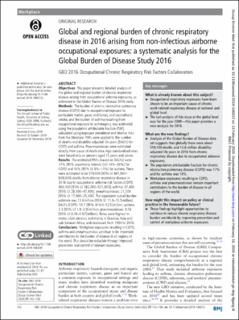| dc.contributor.author | Kisa, Adnan | |
| dc.contributor.author | Chronic Res. Risk Fac.Collabor, GBD 2016 Occupational | |
| dc.date.accessioned | 2022-10-21T12:31:08Z | |
| dc.date.available | 2022-10-21T12:31:08Z | |
| dc.date.created | 2020-02-16T16:12:24Z | |
| dc.date.issued | 2020 | |
| dc.identifier.citation | Occupational and Environmental Medicine. 2020, 77, 142-150. | en_US |
| dc.identifier.issn | 1351-0711 | |
| dc.identifier.uri | https://hdl.handle.net/11250/3027596 | |
| dc.description.abstract | Objectives This paper presents detailed analysis of the global and regional burden of chronic respiratory disease arising from occupational airborne exposures, as estimated in the Global Burden of Disease 2016 study. Methods The burden of chronic obstructive pulmonary disease (COPD) due to occupational exposure to particulate matter, gases and fumes, and secondhand smoke, and the burden of asthma resulting from occupational exposure to asthmagens, was estimated using the population attributable fraction (PAF), calculated using exposure prevalence and relative risks from the literature. PAFs were applied to the number of deaths and disability-adjusted life years (DALYs) for COPD and asthma. Pneumoconioses were estimated directly from cause of death data. Age-standardised rates were based only on persons aged 15 years and above. Results The estimated PAFs (based on DALYs) were 17% (95% uncertainty interval (UI) 14%–20%) for COPD and 10% (95% UI 9%–11%) for asthma. There were estimated to be 519 000 (95% UI 441,000– 609,000) deaths from chronic respiratory disease in 2016 due to occupational airborne risk factors (COPD: 460,100 [95% UI 382,000–551,000]; asthma: 37,600 [95% UI 28,400–47,900]; pneumoconioses: 21,500 [95% UI 17,900–25,400]. The equivalent overall burden estimate was 13.6 million (95% UI 11.9–15.5 million); DALYs (COPD: 10.7 [95% UI 9.0–12.5] million; asthma: 2.3 [95% UI 1.9–2.9] million; pneumoconioses: 0.58 [95% UI 0.46–0.67] million). Rates were highest in males; older persons and mainly in Oceania, Asia and sub-S aharan Africa; and decreased from 1990 to 2016. Conclusions Workplace exposures resulting in COPD, asthma and pneumoconiosis continue to be important contributors to the burden of disease in all regions of the world. This should be reducible through improved prevention and control of relevant exposures. | en_US |
| dc.description.sponsorship | The overall GBD study is partly funded by the Bill & Melinda Gates Foundation. The work reported in this paper was partly supported by funding from the World Health Organization. The funders had no role in the study design, data collection, data analysis, data interpretation or writing of the report. The authors had access to the data in the study and the final responsibility to submit the paper. | en_US |
| dc.language.iso | eng | en_US |
| dc.relation.uri | https://oem.bmj.com/content/77/3/142 | |
| dc.rights | Navngivelse 4.0 Internasjonal | * |
| dc.rights.uri | http://creativecommons.org/licenses/by/4.0/deed.no | * |
| dc.title | Global and regional burden of chronic respiratory disease in 2016 arising from non-infectious airborne occupational exposures: a systematic analysis for the Global Burden of Disease Study 2016 | en_US |
| dc.type | Peer reviewed | en_US |
| dc.type | Journal article | en_US |
| dc.description.version | publishedVersion | en_US |
| dc.source.pagenumber | 142-150. | en_US |
| dc.source.volume | 77 | en_US |
| dc.source.journal | Occupational and Environmental Medicine | en_US |
| dc.identifier.doi | 10.1136/oemed-2019-106013 | |
| dc.identifier.cristin | 1794486 | |
| cristin.unitcode | 1615,40,10,0 | |
| cristin.unitname | Institutt for helsevitenskap | |
| cristin.ispublished | true | |
| cristin.fulltext | original | |
| cristin.qualitycode | 2 | |

